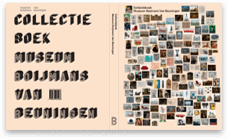For the exhibition 'Het ontstaan der dingen' [The way things came about], Dick van Hoff, in a reaction to the large number of largely superfluous electric kitchen aids, designed four prototypes that are operated by hand, just as they were in the past. The kitchen machine, blender, mixer and juicer, made of cast iron, porcelain, glass and oak, are fitted with tooth and fly wheels, so that each kitchen chore is simplicity itself.

Specifications
| Title | Tirannie van de stekker |
|---|---|
| Material and technique | Cast iron, chrome, glass, synthetics, ceramics and wood |
| Object type |
Blender
> Household equipment
> Kitchen and household
> Utensil
|
| Location | This object is in storage |
| Dimensions |
Width 18 cm Height 41 cm |
|---|---|
| Artists |
Designer:
Dick van Hoff
|
| Accession number | V 2257 b1 - b4 (KN&V) |
| Credits | Purchased with the support of Mondriaan Fund, 2003 |
| Department | Applied Arts & Design |
| Acquisition date | 2003 |
| Creation date | in 2003 |
| Internal exhibitions |
Hand Made - Long Live Craft (2013) |
| Material | |
| Object |























